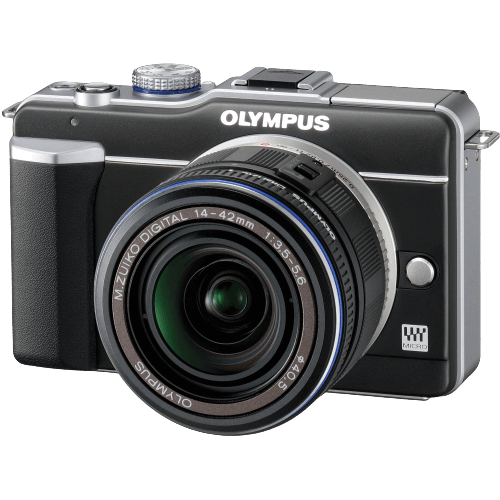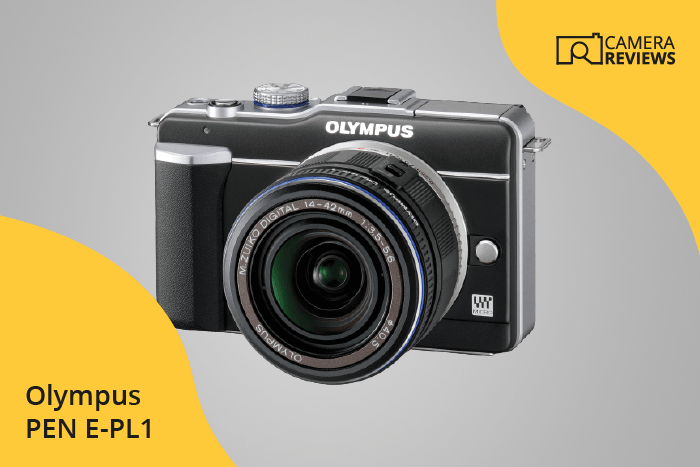Olympus PEN E-PL1 Specs and Scores

The Olympus PEN E-PL1 receives a score of 39/100 for its general specifications. Announced on February 3rd, 2010, and released the same year, this mirrorless camera entered the market with a launch price of $599. The E-PL1 measures 115 x 72 x 42mm and weighs 334g or 0.74lbs.
Comparing these specs to today’s market, the Olympus PEN E-PL1 shows its age. While it offered decent features in 2010, it struggles to compete with the advancements and innovations in current camera models. Nevertheless, it remains a part of Olympus’ reputable camera lineup.
Olympus PEN E-PL1 Overview and Optics
The Olympus PEN E-PL1 optics receive a score of 43 out of 100. This camera is equipped with a 12.3-megapixel sensor and a TruePic V processor. The sensor size is Micro Four Thirds, which is smaller than the APS-C sensors found in many current mirrorless cameras. Despite its smaller size, the sensor has a DXOMARK score of 54, which is decent for its class.
This camera has a Micro 4/3 lens mount, offering compatibility with a wide range of lenses. The E-PL1 also includes image stabilization, a useful feature for reducing camera shake and improving image quality. Its shooting speed is 3 frames per second, which is slower than many modern cameras but still sufficient for casual photography. The aspect ratio is the standard 4:3.
Olympus PEN E-PL1 Video Performance
The Olympus PEN E-PL1 receives a video score of 34 out of 100. This camera offers standard high-definition video with a maximum resolution of 1280 x 720 pixels. The video frame rate reaches a maximum of 30 frames per second. However, this camera lacks built-in time-lapse functionality.
Comparing these video specifications to modern cameras, the E-PL1 falls behind in terms of resolution and features. Many current cameras provide higher resolutions, such as 4K, and additional functionalities. The absence of time-lapse capabilities further contributes to the E-PL1’s lower video performance.
Taking these factors into account, the Olympus PEN E-PL1’s video capabilities are not competitive in today’s market. While it may suffice for casual users, those seeking advanced video features should consider other options.
Olympus PEN E-PL1 Features and Benefits
The Olympus PEN E-PL1 receives a feature score of 34/100. This score reflects the camera’s available specifications, which include a 2.7-inch screen with a resolution of 230,000 dots. The camera lacks a touchscreen, flip screen, GPS, WIFI, and Bluetooth capabilities.
Compared to today’s market, the E-PL1 falls short in terms of modern features. The absence of a touchscreen, flip screen, and connectivity options like WIFI and Bluetooth make the camera less versatile and user-friendly for contemporary photographers. The screen resolution is also low when considering the high-resolution displays available on current camera models.
The Olympus PEN E-PL1’s features do not meet the standards of current market offerings. The camera’s limited specifications hinder its usability and adaptability for modern photography needs.
Olympus PEN E-PL1 Storage and Battery
The Olympus PEN E-PL1 receives a storage and battery score of 16/100. This camera has only one memory card slot, accepting SD and SDHC cards. In today’s market, this may not be sufficient for those who require extensive storage or the convenience of multiple cards.
Regarding battery life, the E-PL1 can capture up to 290 shots with its BLS-1 battery. This battery life may fall short for extended photography sessions and does not support USB charging. Consequently, the E-PL1’s storage and battery capabilities may not meet the demands of contemporary users seeking advanced features and performance.
Olympus PEN E-PL1 Alternatives
Do you want to know how the Olympus PEN E-PL1 compares to its competitors? Have a look at the most popular comparisons for this camera below:
- Canon EOS R5 vs Olympus PEN E-PL1
- Canon EOS R50 vs Olympus PEN E-PL1
- Olympus PEN E-PL1 vs Sony a6500
You can also try these trending comparisons for inspiration:
- Olympus OM-D E-M1 Mark II vs Sony a7C
- Fujifilm X-S10 vs Olympus OM-D E-M5 Mark III
- Olympus Tough TG-870 vs Sony ZV-1
- Fujifilm X-T30 II vs Olympus OM-D E-M5 Mark III
- Olympus OM-D E-M10 Mark III vs PEN E-PL7
Olympus PEN E-PL1 FAQ
Does the Olympus PEN E-PL1 Have Built-in Image Stabilization?
Yes, the Olympus PEN E-PL1 features built-in image stabilization, which helps to reduce camera shake and produce sharper images, especially in low-light conditions or when using longer focal lengths.
Does the Olympus PEN E-PL1 Support 4K Video Recording?
No, the Olympus PEN E-PL1 does not support 4K video recording. The maximum video resolution it offers is Standard HD (1280×720 pixels) at 30 frames per second.
What Size Sensor Does The Olympus PEN E-PL1 Have?
The Olympus PEN E-PL1 is equipped with a Micro Four Thirds sensor, which is a popular choice for mirrorless cameras due to its compact size and good image quality.
Does the Olympus PEN E-PL1 Have a Dual Memory Card Slot?
No, the Olympus PEN E-PL1 has only a single memory card slot, which supports SD, SDHC, and SDXC cards for storage.
Does the Olympus PEN E-PL1 Have a Touch Screen?
No, the Olympus PEN E-PL1 does not feature a touch screen. The camera is controlled using physical buttons and dials on the body.
Does the Olympus PEN E-PL1 Have Wi-Fi and Bluetooth?
Unfortunately, the Olympus PEN E-PL1 does not have built-in Wi-Fi or Bluetooth connectivity for wireless image transfer or remote control.
Does the Olympus PEN E-PL1 Have GPS?
No, the Olympus PEN E-PL1 does not have built-in GPS functionality for geotagging photos or tracking locations.
Is the Olympus PEN E-PL1 Weather Sealed?
No, the Olympus PEN E-PL1 is not weather sealed, so it is not recommended to use it in extreme weather conditions or wet environments without proper protection.
Does the Olympus PEN E-PL1 Have a Built-in Flash?
Yes, the Olympus PEN E-PL1 comes with a built-in flash, which can be useful for fill-in flash or low-light situations when an external flash is not available.

